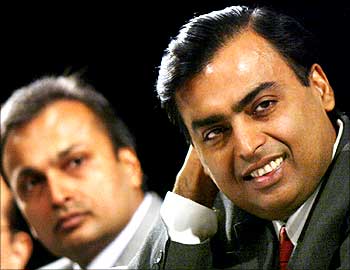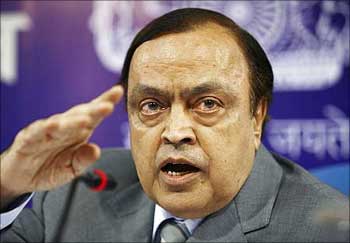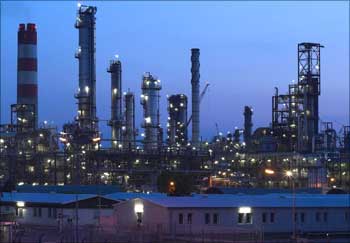 | « Back to article | Print this article |
Why Ambani brothers are locking horns again
The latest Ambani-sibling fight has now become a political battle. The fight for gas supplies between Mukesh Ambani's Reliance Industries Ltd and Anil's Reliance Natural Resources Ltd has also put the government on the backfoot.
Read on to find out how the events unfolded...
What is the fight about?
Mukesh Ambani's Reliance Industries Limited agreed to sell Anil Ambani's Reliance Natural Resources Limited 80 mmscmd of gas from the Krishna-Godavari Basin for 17 years at $2.34 per mmbtu - for its Dadri power plant.
With RIL not supplying the gas, RNRL went to court against it for not implementing this part of a family MoU signed when the empire was being carved up between the two brothers.
Why Ambani brothers are locking horns again
Where does the petroleum ministry come in?
RIL got the right to look for gas in the KG Basin after signing a Production Sharing Contract with the government.
In the PSC, the government gets a share of RIL's KG profits.
Since profits are related to the price, the government says it has the right to vet each contract RIL signs to sell gas. The ministry used this to reject the RIL-RNRL contract, saying it was not an arms-length one.
Why Ambani brothers are locking horns again
So what's the problem?
RNRL argues the ministry's role under the PSC is limited to ensuring it gets its fair share of profits - theoretically, RIL can give the gas away free as long as it gives the government its share of the profit, based on either the price fixed by the government or on a competitive arms-length bidding process.
Interestingly, while answering questions in Parliament, the government stance for years has been that its role is limited to ensuring it gets its share of profits.
The Bombay high court has ruled that the family MoU does not violate the PSC - that is, the ministry could not cancel the RIL-RNRL agreement. RIL challenged this in the Supreme Court.
Why Ambani brothers are locking horns again
How was the contract an arms-length one when there was no bidding?
In 2003, NTPC invited global firms to bid to supply it gas for its Kawas-Gandahar power plants for 17 years.
RIL bid the lowest - $2.34 per mmbtu - and NTPC gave it a Letter of Intent in June 2004.
The RIL-RNRL contract was based on this since it was signed in the same time period - except, the RNRL contract was for 28 mmscmd of gas while the NTPC one was for 12 mmscmd.
RIL later objected to some of the clauses in the NTPC tender and refused to supply the gas. NTPC went to court against RIL. RNRL argues that since the contract was based on the NTPC one, it was an arms-length one.
Why Ambani brothers are locking horns again
What is the market price of this gas?
RIL had called for bids from buyers in April 2007, and they bid an average price of $4.33 per mmbtu. After some minor tweaking, the government accepted $4.20 per mmbtu as the price.
Do RIL and the government lose at the $2.34 price?
Compared to $4.20, they do. RIL's cost of producing gas, according to the Directorate General of Hydrocarbons, is $1.28 per mmbtu, so it doesn't really lose at $2.34 though it does earn less.
The government's gains/losses are more complicated. If gas prices are raised, fertiliser and electricity prices also go up and consumers end up paying more - to keep them at the same level, the hike required in government subsidies will be much more than the increased profits it gets when the gas is priced at $4.20.
Why Ambani brothers are locking horns again
How does RIL's capital expenditure come in here?
Under the PSC, RIL first gets to recover its capital and operating costs out of whatever revenues get generated; it is only after this that the government gets a share in the profits - this share rises as RIL's revenue-to-cost ratio rises.
If its capital expenditure goes up, the government's profits fall.
The DGH says the capital expenditure has been verified by independent experts including the Comptroller and Auditor General - the CAG's report, however, has not been made public. RNRL has pointed out that these experts weren't really independent and were connected with RIL in various ways.
Besides, two of the four-member management committee that okays RIL's costs for the KG Basin are employees of RIL - under the PSC, this will be common for all contractors, not just RIL.
Why Ambani brothers are locking horns again
Is there a larger policy issue here?
The policy through which the government is now allocating gas - Dadri cannot get gas under its allocation formula - came into being seven years after the PSC was signed.
So the issue is whether a government can come up with a policy after private sector players have come in and invested billions.







